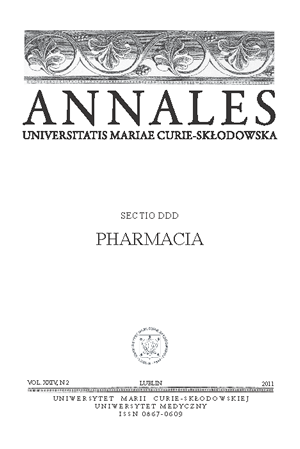Influence of concentration of the urea on the hydrogen peroxide contentin 3% aqueous and non-aqueous solutions stored at different temperatures
Keywords:
hydrogen peroxide, urea, stability, activation energy, storageAbstract
In this study, the stability of the hydrogen peroxide in 3% aqueous and non-aqueous solutions with different amount of urea (2-10%) was examined. The solutions were stored at 20-40° C. The decomposition process proceeded according to first-order. The decomposition rate constant of the hydrogen peroxide increased with the increase of urea and the activation energy decreased. The storage temperature also had influence on decomposition of the active substance. Solutions of the hydrogen peroxide prepared with polyethylene glycol 300, stabilized with 6% addition of urea were more stable than analogous aqueous solutions.
References
1. Ahmad S.: Control of skin infections by a combined action of ultraviolet A (from sun or UVA lamp) and hydrogen peroxide (HUVA therapy), with special emphasis on leprosy. Med. Hypotheses., 57, 484, 2001.
2. Alfa M., Jackson M.: A new hydrogen peroxide-based medical-device detergent with germicidal properties : comparison with enzymatic cleaners. Am. J. Infect. Control., 29, 168, 2001.
3. Azrak B. et al.: Influence of bleaching agents on surface roughness of sound or eroded dental enamel specimens. J. Esthet. Restor. Dent., 22,391,2010.
4. Berger S. et al.: Changes in the stiffness of demineralized dentin following application of tooth whitening agents. Acta Odontol. Scand., 15,1,2011.
5. Biss R. et al.: Process for producing PVP-hydrogen peroxide complex. PCT Int. Appl. WO 92 17,158 (Cl. A61K7/40), 15 Oct 1992, US Appl. 683, 467, 8 Apr 1991.
6. Bradecka B., Krystek A.: Preparation of stable sodium percarbonate, an ecologically safe bleach. Przem. Chem., 70, 430, 1991.
7. Christensen O., Anehus S.: Hydrogen peroxide cream: An alternative to topical antibiotics in the treatment of impetigo contaginosa. Acta. Derm. Venereol., 74, 460, 1994.
8. Polish Pharmacopoeia VI. Warsaw 1992.
9. Fatakdawala H., Uhland S.: Hydrogen peroxide mediated transvaginal drug delivery.Int. J. Pharm., 16, 409, 2011.
10. Gerlach R. et al.: Initial color change and color retention with a hydrogen peroxide bleaching strip. Am. J. Dent., 15, 3, 2002.
11. Militly I. et al.: Improved parameter estimation in Arrhrnius typy models. Termochim.Acta., 92, 77, 1985.
12. Mishra N. et al.: Study on antioxidant activity of common dry fruits. Food Chem. Toxicol., 48, 3316, 2010.
13. Muangrat R. et al.: Alkaline subcritical water gasification of dairy industry waste (Whey). Bioresour. Technol., 102, 6331, 2011.
14. Sankar M. et al.: Oxidation of glycerol to glycolate by using supported gold and palladium nanoparticles. Chem.Sus.Chem., 2, 1145, 2009.
15. Zhang W., Qu G.: Synthesis and application prospect of ureaperoxide. Shanghai Huagong,, 23, 36, 1998.
Downloads
Published
Issue
Section
License
Copyright (c) 2011 Authors

This work is licensed under a Creative Commons Attribution-NonCommercial-NoDerivatives 3.0 Unported License.


